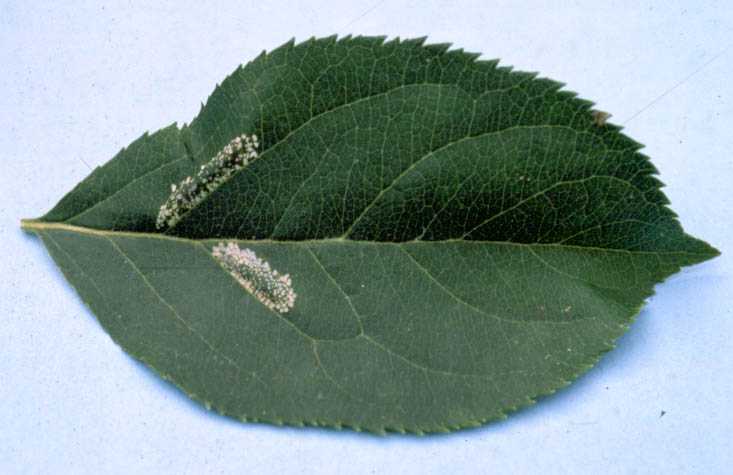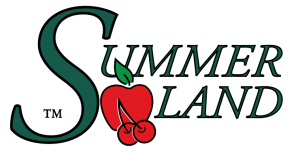Tentiform Leafminer
General Description
Tentiform leafminer is currently a minor pest in orchards in the Similkameen and Okanagan valleys due to effective biological control by a small parasitic wasp that spread with the leafminer when it entered the region in the 1980's.
Hosts
Apple, pear and cherry.
Damage
Leaves - Young larvae (sap-feeders) cause blotch-shaped mines that are visible only from the underside of the leaf (Fig. 1).
.jpg) |
| Figure 1. Sap-feeder larval feeding damage to underside of apple leaf. (BCMA) |
Older larvae (tissue-feeders) produce speckled tent-shaped mines on the upper side of the leaf (Fig. 2).
 |
| Figure 2. Tissue-feeder larval feeding damage. (BCMA) |
Premature leaf drop can occur when third-generation larvae are present in August, especially if the trees are under stress due to some other factor(s). Most premature leaf drop has been reported with nursery stock and young trees.
Fruit - Larvae do not attack the fruit but can affect the fruit through their damage to the leaves. Only very high infestations of leafminers have the potential to reduce fruit quality and size. Early fruit drop, increased sunburn, reduced soluble solids and stunted shoot growth are other reported effects of severe leafminer infestations. Because certain tree management practices can also cause the same type of losses, care must be taken in blaming such effects on leafminers.
Identification
Sap-feeding larva - White, flat, wedge-shaped, legless, 1- 2.25 mm long.
Tissue feeding larva - White or yellow, cylindrical, with legs, 2.5 - 4.5 mm long.
Pupa - Yellow to dark brown, cylindrical, pointed at one end; remains in mine but partially exits to allow moth to emerge.
Adult - 3-5 mm long moths with gold-bronze forewings streaked with white and held roof-like over the body when at rest.
Life History
Tentiform leafminer overwinters as pupae in leaves on the orchard floor. Adults emerge before apple bloom. Females lay their eggs on the underside of leaves. Upon hatching the small larvae enter the leaves and feed on the tissue causing mines in which they later pupate. There are 2-3 complete generations per year.
Monitoring
Monitoring can determine the average number of mines per leaf and the percentage of leafminers killed by parasites (see Control -Biological below). Contact the Kelowna BCMA office for a copy of the fact sheet Sampling Procedures for Tentiform Leafminer and its Parasites which describes how to sample for leafminers and parasites. If you need assistance in determining the level of parasitism, contact your crop management advisor.
Management
Biological Control
Tentiform leafminer is kept below damaging levels by a small parasitic wasp, Pnigalio flavipes. It kills by feeding on and laying an egg in tentiform leafminer larvae. It usually takes 1-2 years after the first introduction of the leafminer in an orchard before the parasite controls the pest. Thirty percent parasitism of the first-generation tissue-feeder larvae in the spring should provide effective biological control for the rest of the season and, in the absence of harmful pesticides, for future seasons.
Chemical Control
Parasites prevent leafminers from causing economic damage during normal growing seasons. However, when third-generation leafminer larvae appear in August, some damage can occur as described above. The tentiform leafminer and its major parasite are resistant to Imidan. Attempts to control tentiform leafminers in other fruit-growing regions with pyrethroids and carbamates have destroyed predators and parasites, induced further resistance development in the leafminer and led to outbreaks of leafminers, mites and woolly apple aphids.
When tentiform leafminer abundance reaches the action level (refer to above fact sheet), apply Admire, Alias, Assail or Agri-Mek (plus 0.25% summer oil) or Altacor or Delegate when the leafminer population is mainly in the sap-feeder stage. A second application may be required if severe pressure continues or generations are overlapping. Alternatively, apply Confirm or Intrepid at first egg hatch of the first generation only.
Admire, Alias and Assail are in the same chemical group so rotate their use with Agri-Mek or Altacor or Delegate to reduce the risk of pesticide resistance development. Do not apply more than two applications of Alias, Assail or Admire either alone or alternately per season regardless of target pest (codling moth, aphids, leafhoppers, leafminers) to avoid possible mite flare-up. Assail applied when codling moth is laying eggs will aid in control of codling moth.
